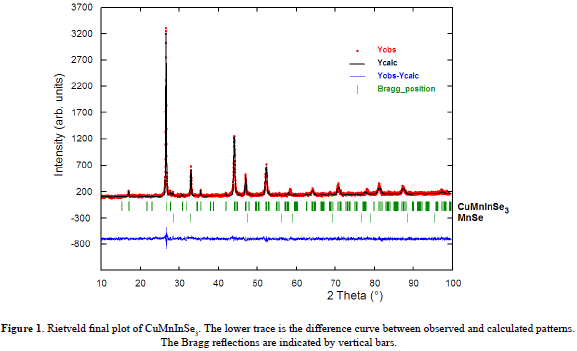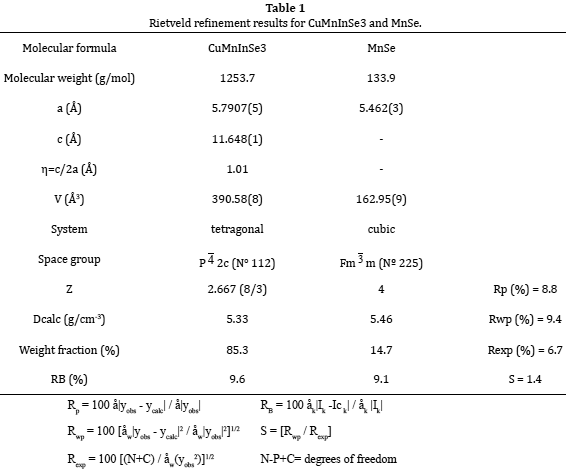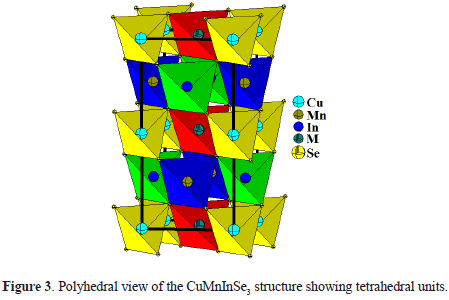Services on Demand
Journal
Article
Indicators
-
 Cited by SciELO
Cited by SciELO -
 Access statistics
Access statistics
Related links
-
 Similars in
SciELO
Similars in
SciELO
Share
Revista Técnica de la Facultad de Ingeniería Universidad del Zulia
Print version ISSN 0254-0770
Rev. Téc. Ing. Univ. Zulia vol.41 no.1 Maracaibo Apr. 2018
Preparation and structural characterization of the new diamond-like semiconductor CuMnInSe3
Gerzon E. Delgado1*, Pedro Grima-Gallardo2,3, Miguel Quintero2, Cecilia Chacón4
1 Laboratorio de Cristalografía, Departamento de Química, Facultad de Ciencias, Universidad de Los Andes, Mérida 5101, Venezuela
2 Centro de Estudios de Semiconductores, Departamento de Física, Facultad de Ciencias, Universidad de Los Andes, Mérida 5101, Venezuela
3 Centro Nacional de Tecnologías Opticas (CNTO), y Centro Investigaciones de Astronomía (CIDA), Mérida 5101, Venezuela
4 Centro de Investigación en Ciencia Aplicada y Tecnología Avanzada-Instituto Politécnico Nacional, México D.F. 11500, México *e-mail: gerzon@ula.ve
Abstract
The chalcogenide compound CuMnInSe3, belonging to the system I-II-III-VI3, has been investigated by means of X-ray powder diffraction and its crystal structure has been refined by the Rietveld method. The powder pattern was composed by 85.3% of the principal phase CuMnInSe3 and 14.7% of the secondary phase MnSe. This material crystallizes with a CuFeInSe3- type structure in the tetragonal space group P ![]() 2c (Nº 112), with unit cell parameters a = 5.7907(5) Å, c = 11.648(1) Å, V = 390.58(8) Å3.
2c (Nº 112), with unit cell parameters a = 5.7907(5) Å, c = 11.648(1) Å, V = 390.58(8) Å3.
Keywords: Chalcogenides; Semiconductors; Chemical synthesis; X-ray diffraction; Crystal structure.
Preparación y caracterización estructural del nuevo semiconductor tipo-diamante CuMnInSe3
Resumen
El compuesto calcogenuro CuMnInSe3, perteneciente al sistema I-II-III-VI3, ha sido investigado mediante difracción de rayos-X en muestras policristalinas y su estructura cristalina ha sido refinada utilizando el método Rietveld. El patrón de polvo se compone de 85,3 % de la fase principal CuMnInSe3 y 14,7 % de la fase secundaria MnSe. Este material cristaliza con una estructura tipo CuFeInSe3 en el grupo espacial P ![]() 2c, (N° 112), con parámetros de celda unidad a = 5,7907(5) Å, c = 11,648(1) Å, V = 390,58(8) Å3.
2c, (N° 112), con parámetros de celda unidad a = 5,7907(5) Å, c = 11,648(1) Å, V = 390,58(8) Å3.
Palabras clave: Calcogenuros; Semiconductores; Síntesis química; Datos de difracción de polvo; Estructura cristalina.
Recibido el 9 de Enero de 2017
En forma revisada el 19 de Octubre de 2017
Introduction
The chalcopyrite family of compounds I-III-VI2 (I = Cu, Ag, III = Al, Ga, In, VI = S, Se, Te) form a wide group of chalcogenide semiconductor materials with diverse optical and electrical properties [1]. They crystallize with tetragonal symmetry in the space group I ![]() 2d (N°122), and the addition of a II-VI (II = Zn, Cd, Mn, Fe) binary compound produces alloys of the type (I-III-VI2)1-X(II-VI)X [2]. Due to the great variety of possible compositions, these materials can be useful for applications such as tunable semiconductors [3], photovoltaics [4], spintronics [5], non-linear optics [6] and thermoelectrics [7].
2d (N°122), and the addition of a II-VI (II = Zn, Cd, Mn, Fe) binary compound produces alloys of the type (I-III-VI2)1-X(II-VI)X [2]. Due to the great variety of possible compositions, these materials can be useful for applications such as tunable semiconductors [3], photovoltaics [4], spintronics [5], non-linear optics [6] and thermoelectrics [7].
The formation of some quaternary with compositions Cu-II-III-Se3 (x = ½), Cu-II2-III-Se4 (x =2/3) and Cu2-II-III-Se5 (x = 1/3) have been reported [8-11], and the first crystal structure characterization of one I-II-III-VI3 semiconductor member, indicated a degradation of symmetry from the chalcopyrite structure I ![]() 2d to a related tetragonal structure P
2d to a related tetragonal structure P ![]() 2c [12].
2c [12].
In recent years, it has been of interest to carry out a systematic study of the crystal structure of quaternary diamond-like families [13-17]. Hence, here we report herein the structural characterization of a new quaternary compound, CuMnInSe3, using the Rietveld method from X-ray powder diffraction data.
Experimental
Starting materials (Cu, Mn, In and Se) with a nominal purity of (at least) 99.99 wt% in the stoichiometric ratio were mixed together in an evacuated and sealed quartz tube, which was previously subjected to pyrolysis in order to avoid reaction of the starting materials with silica glass. The ampoule was shaken using a mechanical system during the entire heating process in order to aid the complete mixing of all the elements. The maximum temperature (1500K) was held for an additional 48 hours with the mechanical shaking system on. Then, the mechanical shaking system was turning off and the temperature was gradually lowered, at the same rate of 20 K/h, until 850 K. The ampoule was held at this temperature for a period of 30 days. Finally, the sample was cooled to room temperature at a rate of 10 K/h. Previous experience indicates that this procedure usually gives samples showing conditions corresponding to equilibrium near room temperature [8-11].
For the X-ray analysis, a small quantity of the sample was ground mechanically in an agate mortar and pestle. The resulting fine powders, sieved to 46μ, were mounted on a flat zero-background holder (a plate of single crystalline silicon cut parallel to the 510 lattice planes) covered with a thin layer of petroleum jelly. The X-ray powder diffraction data were collected at 293(1) K, in q/q reflection mode using a Siemens D5005 diffractometer equipped with an X-ray tube (CuKα radiation: λ= 1.54056 Å; 40kV, 30mA) using a secondary beam graphite monochromator. A fixed aperture and divergence slit of 1 mm, a 1 mm monochromator slit, and a 0.1 mm detector slit were used. The specimens were scanned from 10°- 100° 2q, with a step size of 0.02° and counting time of 40s. Quartz was used as an external standard.
Results and discussion
Figure 1 shows the resulting X-ray powder diffractogram for the CuMnInSe3 compound. An automatic search in the PDF-ICDD database [18], using the software available with the diffractometer, indicated that the powder pattern contained small amounts of MnSe (PDF N° 11-683), Bragg positions of the diffraction lines from this compound are also indicated in Figure 1. The 20 first peak positions of the main phase (CuMnInSe3) were indexed using the program Dicvol04 [19], which gave a unique solution in a tetragonal cell with a = 5.789(2) Å and c = 11.647(4) Å. These values are similar in magnitude to the parent chalcopyrite structure of CuInSe2 (a = 5.781(1) Å, c = 11.642(3) Å) [20]. The lack of systematic absence condition h+k+l in the general reflections of the type hkl indicated a P-type cell. A revision of the diffraction lines of the main phase taking into account the sample composition, unit cell parameters as well as the primitive cell suggested that this material is isostructural with the CuFeInSe3-type compound, which crystallize in the tetragonal space group P ![]() 2c (Nº 112) [12].
2c (Nº 112) [12].
The Rietveld refinement [21] was carried out using the Fullprof program [22]. The atomic coordinates of CuFeInSe3 [12] were used as starting model for the quaternary CuMnInSe3. Atomic positions of the MnSe binary [23] were included as secondary phase in the refinement. The angular dependence of the peak full width at half maximum (FWHM) was described by the Cagliotis formula [24]. Peak shapes were described by the parameterized Thompson-Cox-Hastings pseudo- Voigt profile function [25]. The background variation was described by a polynomial with six coefficients. The thermal motion of the atoms was described by one overall isotropic temperature factor. The results of the Rietveld refinement are summarizes in Table 1. Figure 1 show the observed, calculated and difference profile for the final cycle of Rietveld refinement. Atomic coordinates, isotropic temperature factor, bond distances and angles are shown in Table 2. The final Rietveld refinement converged to the following weight fraction percentages: CuMnInSe3 (85.3%) and MnSe (14.7%) [26].
An important structural characteristic is the parameter of tetragonal lattice distortion, which is determined as a deviation of the ratio η = c/2a (a and c are unit-cell parameters) from unity [27]. The value of η show in Table 1, close to unity, is indicative of small lattice distortions in the sample synthesized.
CuMnInSe3 is a normal adamantane-structure compound [2], where occurs a degradation of symmetry from the chalcopyrite structure I ![]() 2d to a related structure P
2d to a related structure P ![]() 2c. This situation can be seen in Figure 2 where a comparison is made between the chalcopyrite CuInSe2 I
2c. This situation can be seen in Figure 2 where a comparison is made between the chalcopyrite CuInSe2 I ![]() 2d structure and the P
2d structure and the P ![]() 2c structure of CuMnInSe3. Therefore, in this quaternary structure, the introduction of an additional cation (Mn) produces an effect of dilution of this cation in the chalcopyrite structure leaving the cell volume almost unchanged [12].
2c structure of CuMnInSe3. Therefore, in this quaternary structure, the introduction of an additional cation (Mn) produces an effect of dilution of this cation in the chalcopyrite structure leaving the cell volume almost unchanged [12].
In this structure the Se atoms form a close-packed arrangement where each anion is coordinated by four cations located at the corners of a slightly distorted tetrahedron. All cations are similarly coordinated by four anions. Figure 3 shows a polyhedral view of the crystal structure with the four types of atoms-centered tetrahedra CuSe4, MnSe4, InSe4 and MSe4 where all polyhedra are oriented in the same direction and are connected by the corners.
The tetrahedrons containing the In atoms [mean Se Se distance 3.90(1) Å] are slightly smaller than those containing the M (Cu1, Mn1, In1) 3.91(1) Å, Cu atoms [means Se Se distance 3.96(1) Å] and Mn atoms [mean Se Se distance 4.00(1) Å] respectively.
The bond distances Cu-Se [2.428(8) Å], Mn-Se [2.448(8) Å] and In-Se [2.614(8) Å] are in good agreement with those observed in the parent chalcopyrite structure CuInSe2 [20] and other adamantane quaternary compounds such as CuFe(Al,Ga,In)Se3 [12, 14], CuFe2(Al,Ga,In)Se4 [13, 17], Cu2FeSnSe4 [28] and Cu2MnSnSe4 [29].
Conclusions
The crystal structure of the new quaternary compound CuMnInSe3 was determined using X-ray powder diffraction data. This material crystallizes in the tetragonal space group P ![]() 2c, with a CuFeInSe3-type structure. This is a new compound of the I-II-III-VI3 family of semiconductors.
2c, with a CuFeInSe3-type structure. This is a new compound of the I-II-III-VI3 family of semiconductors.
Acknowledgements
This work was supported by CDCHT-ULA (Grant C-1740-11-05-AA and C-1885-14-05-B) and FONACIT (Grants LAB-97000821, PEII-1697 and project N° 2011001341).
References
1. Shay J.L., Wernik J.H.: Ternary chalcopyrite semiconductors: Growth, electronic properties and applications. Pergamon Press., Oxford, 1974. [ Links ]
2. Parthé E.: Wurtzite and Sphalerite Structures. In: J.H. Westbrook, R.L. Fleischer (eds), Intermetallic Compounds, Principles and Applications, Vol. 1, John Wiley & Sons, Chichester, UK (1995). [ Links ]
3. Ford G.M., Guo Q., Agrawal R., Hillhouse H.W., Hugh W.: Earth abundant element Cu2Zn(Sn1-XGeX) S4 nanocrystals for tunable band gap solar cells: 6.8% efficient device fabrication. Chemistry of Materials, Vol. 23, No. 10 (2011) 2626-2629. [ Links ]
4. Guo Q., Ford G.M., Yang W.C., Walker B.C., Stach E.A., Hillhouse H.W., Agrawal R.: Fabrication of 7.2% efficient CZTSSe solar cells using CZTS nanocrystals. Journal of American Chemical Society, Vol. 132, No. 49 (2010) 17384-17386. [ Links ]
5. Chambers S.A., Yoo Y.K: New materials for spintronics, MRS Bulletin, Vol. 28 (2003) 706-710. [ Links ]
6. Li Y., Fan W., Sun H., Cheng X., Li P., Zhao X.: Electronic, optical and lattice dynamic properties of the novel diamond-like semiconductors Li2CdGeS4 and Li2CdSnS4. Journal of Physics: Condensed Matter, Vol. 23, No. 22 (2011) 11. [ Links ]
7. Sevik C., Ca T.: Ab initio study of thermoelectric transport properties of pure and doped quaternary compounds. Physical Review B, Vol. 82, No. 4 (2010), 7. [ Links ]
8. Grima-Gallardo P., Cárdenas K., Quintero M., Ruiz J., Delgado G.E.: X-ray diffraction studies on (CuAlSe2) X(FeSe)1-X alloys. Materials Research Bulletin, Vol. 36, No. 6 (2001) 861-866. [ Links ]
9. Grima-Gallardo P., Muñoz M., Delgado G.E., Briceño J.M., Ruiz J.: The (CuGaSe2)1-X(MgSe)X alloy system (0 ≤ x ≤ 0.5): X-ray diffraction, energy dispersive spectrometry and differential thermal analysis. physica status solidi (b), Vol. 241, No. 8 (2004) 1789-1794. [ Links ]
10. Grima-Gallardo P., Muñoz M., Durán S., Delgado G.E., Quintero M., Ruiz J.: Preparation and investigation of the quaternary alloy CuTaInSe3. Materials Research Bulletin, Vol. 42, No. 12 (2007) 2067-2071. [ Links ]
11. Grima-Gallardo P., Torres S., Quintero M., Nieves L., Moreno E., Delgado G.E.: Phase Diagram of (CuInSe2)1-x(FeSe)x alloys. Journal of Alloys and Compounds, Vol. 630, No. 5 (2015) 146-150. [ Links ]
12. Mora A.J., Delgado G.E., Grima-Gallardo P.: Crystal structure of CuFeInSe3 from X-ray powder diffraction data. physica status solidi (a), Vol. 204, No. 2 (2007) 547-554. [ Links ]
13. Delgado G.E., Mora A.J., Grima-Gallardo P., Quintero M.: Crystal structure of CuFe2InSe4 from X-ray powder diffraction. Journal of Alloys and Compounds, Vol. 454, No. 1 (2008) 306-309. [ Links ]
14. Delgado G.E., Mora A.J., Contreras J.E., Grima-Gallardo P., Durán S., Muñoz M., Quintero M.: Crystal structure characterization of the quaternary compounds CuFeAlSe3 and CuFeGaSe3. Crystal Research and Technology, Vol. 44, No. 5 (2009) 548-552. [ Links ]
15. Delgado G.E., Mora A.J., Grima-Gallardo P., Durán S., Muñoz M., Quintero M.: Preparation and crystal structure analysis of CuNiGaSe3 and CuNiInSe3 quaternary compounds. Bulletin of Materials Science, Vol. 33, No. (5) (2010) 637-640. [ Links ]
16. Delgado G.E., Quintero E., Tovar R., Grima-Gallardo P., Quintero M.: Synthesis and crystal structure of the quaternary compound AgFe2GaTe4. Journal of Alloys and Compounds, Vol. 613, No. 1 (2014) 143-145. [ Links ]
17. Delgado G.E., Mora A.J., Grima-Gallardo P., Muñoz M., Durán S., Quintero M., Briceño J.M.: Crystal structure of the quaternary compounds CuFe2AlSe4 and CuFe2GaSe4 from X-ray powder diffraction. Bulletin of Materials Science, Vol. 38, No. 4 (2015) 1061-1064. [ Links ]
18. International Centre for Diffraction Data (ICDD), Powder Diffraction File (Set 1-65). Newtown Square, PA, USA, 2013. [ Links ]
19. Boultif A., Louër D.: Powder pattern indexing with the dichotomy method. Journal of Applied Crystallography, Vol. 37, No. 5 (2004) 724-731. [ Links ]
20. Knight K.S. The crystal structures of CuInSe2 and CuInTe2. Materials Research Bulletin, Vol. 27, No. 2 (1992) 161-167. [ Links ]
21. Rietveld H.M.: A profile refinement method for nuclear and magnetic structures. Journal of Applied Crystallography, Vol. 2, No. 2 (1969) 65-71. [ Links ]
22. Rodriguez-Carvajal J.: Recent advances in magnetic structure determination by neutron powder diffraction. Physica B: Condensed Matter, Vol. 192, Nos. 1-2 (1993) 55-69. [ Links ]
23. Johnston W.D., Heikes R.R.: A Study of the System LiXMn(1-X)Se. Journal of American Chemical Society, Vol. 80, No. 22 (1958) 5904-5907. [ Links ]
24. Cagliotti G., Paoletti A., Ricci F.P.: Choice of collimators for a crystal spectrometer for neutron diffraction. Nuclear Instruments, Vol. 3, No. 4 (1958) 223-228. [ Links ]
25. Thompson P., Cox D.E., Hastings J.B.: Rietveld refinement of Debye-Scherrer synchrotron X-ray data from Al2O3. Journal of Applied Crystallography, Vol. 20, No. 2 (1987) 79-83. [ Links ]
26. Hill R.J., Howard J.C.: Quantitative phase analysis from neutron powder diffraction data using the Rietveld method. Journal of Applied Crystallography, Vol. 20, No. 6 (1987) 467-474. [ Links ]
27. Rodulfo de Gil E.: Ternary semiconducting compounds with chalcopyrite-type structure: I. Fundamental equation and its physically acceptable solutions. physica status solidi (a), Vol. 70, No. 2 (1982) 519-523. [ Links ]
28. Roque-Infante E., Delgado J.M., López-Rivera S.A.: Synthesis and crystal structure of Cu2FeSnSe4, a I2 III V VI4 semiconductor. Materials Letters, Vol. 33, No. 1-2 (1997) 67-70. [ Links ]
29. Sachanyuk V.P., Olekseyuk I.D., Parasyuk O.V.: X-ray powder diffraction study of the Cu2Cd1-XMnXSnSe4 alloys. physica status solidi (a), Vol. 203, No. 3 (2006) 459-465. [ Links ]


















